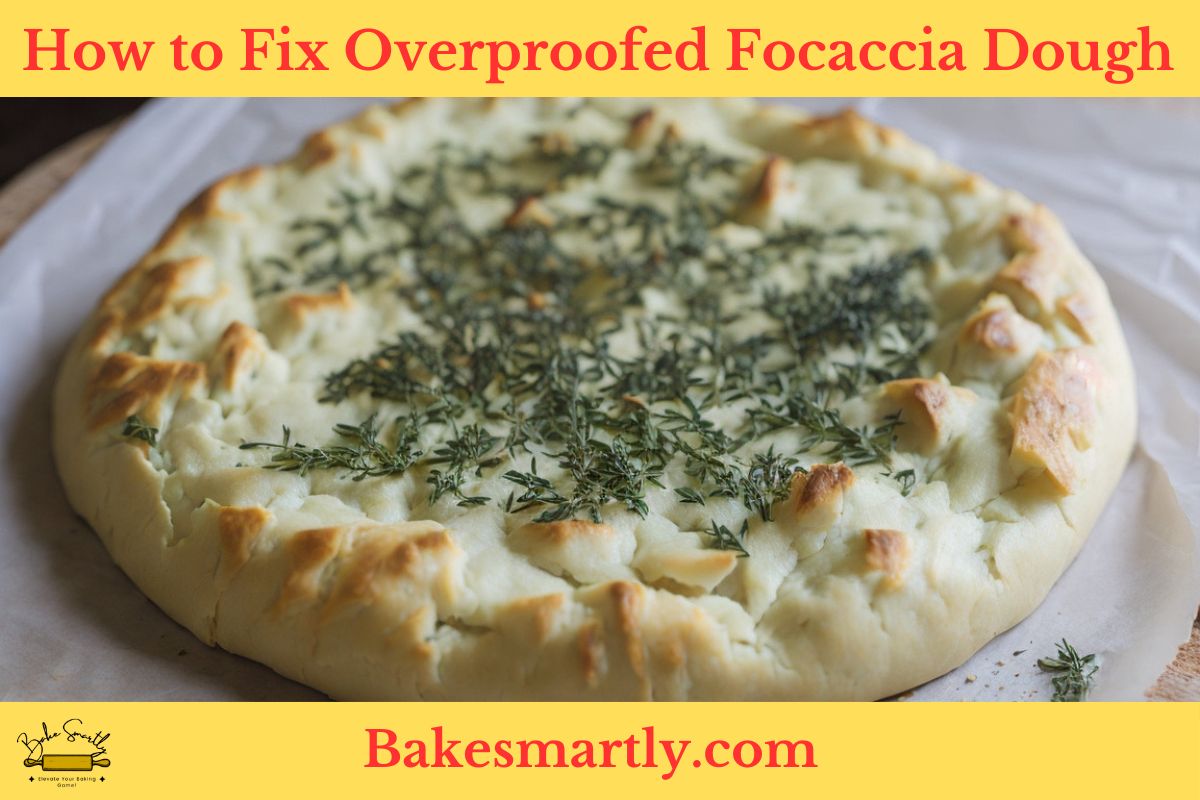
Focaccia, with its light and tasty crust, has become a favorite in many kitchens. But even experienced bakers can run into issues, and one big problem is overproofing.
In this guide, we’ll look at how to save and avoid overproofed focaccia while diving into the fascinating world of bread-making.
Table of Contents
ToggleSigns of Overproofed Focaccia Dough
Overproofing happens a lot when you’re making focaccia, and it’s important to spot the signs early to save your dough. Here are four unmistakable signs that your focaccia may have fallen victim to overproofing.
- What You See: Overproofing is pretty obvious when you look at your dough. An overproofed focaccia dough loses its shape, getting too puffy and slack. Instead of rising evenly, you’ll see weird bubbles and it might look fragile. The once-solid structure falls apart, telling you the fermentation went too far.
- Smell Check: Your nose can clue you in on focaccia. A well-proofed dough gives off a tempting aroma, showing that the flavors are developing just right during fermentation. But if it starts to smell weird—sour or just off—that’s a sign of overproofing. If your focaccia doesn’t smell as good as usual, it’s time to rethink how long you’ve let it proof.
- Dough Explosion: Dough is supposed to expand a bit during proofing, but overproofing takes it to the extreme. If your focaccia dough blows up like an overinflated balloon, that’s a clear sign of overproofing. Too much carbon dioxide from the yeast during a long fermentation messes with the structure of the final product.
- Finger Dent Fail: Good bakers often use the finger dent test to check if the dough is ready. But with overproofed focaccia, the test shows a lack of bounce-back. When you poke the dough, it might not spring back like it should. Instead, the dent stays, telling you the dough lost its stretchiness. If your focaccia fails the finger dent test, it’s a big clue that it proofed for too long.

3 Methods to Fix Overproofed Focaccia
So, your focaccia dough got a bit carried away with proofing, and now it seems like all is lost? Don’t worry! With a few smart moves and some baking know-how, you can rescue your dough and still end up with a delicious focaccia.
Here are three practical ways to fix overproofed focaccia:
Gently Reshape the Dough
To save overproofed focaccia, start by gently reshaping the dough.
Carefully move the dough onto a well-floured surface, being careful not to squash it too much. With lightly floured hands, fold the edges of the dough toward the center, forming a rough ball.
This helps redistribute the yeast and gases, allowing for a more controlled rise during the second proof.
Once reshaped, put the dough back into the proofing container or on a baking sheet, covering it with a damp cloth. Let it go through a shorter second proofing period to regain some structure. Keep a close eye on it to make sure it doesn’t overproof again.
Adjust Baking Temperature and Time
Another effective way to counteract overproofing is to make some tweaks to the baking temperature and time.
Preheat your oven to the recommended focaccia temperature, but be ready to lower it a bit. A lower temperature slows down the yeast activity, preventing further expansion during baking.
When placing the reshaped dough in the oven, closely watch the baking time. Opt for a shorter duration than usual to avoid making the overproofing worse. Keep an eye on the color and texture, adjusting as needed.
This method lets you control the final result and minimize the impact of overproofing on your focaccia’s texture and flavor.
Use the Sponge Method
For a more advanced approach, think about incorporating the sponge method during the second proof.
This means making a small separate mixture of flour, water, and yeast to kickstart fermentation. Mix these ingredients into a thick batter and let it sit for about 30 minutes. Then, gently fold this sponge into your overproofed dough.
The sponge brings in fresh yeast and encourages a more controlled rise, counteracting the effects of overproofing. This method not only rescues the dough but can also enhance the overall flavor of your focaccia.
Remember, flexibility is crucial when trying out these methods. The exact adjustments might vary based on factors like room temperature, types of flour, and humidity levels.
Common Mistakes to Avoid When Fixing Overproofed Focaccia
Fixing overproofed focaccia can be totally doable, but there are some common pitfalls even seasoned bakers might run into. Knowing and avoiding these slip-ups is key to rescuing your dough successfully. Check out these key errors to steer clear of:
- Don’t Rush the Reshaping: A big mistake is speeding through the dough reshaping part. Dealing with overproofed dough needs some patience and a gentle hand. Don’t rush it, as quick moves can squash the dough more, making the overproofing worse. Take your time and let the dough get back some structure on its own.
- Don’t Forget the Second Proof: After reshaping, it’s tempting to skip or cut short the second proofing time. But this step is crucial for the dough to bounce back and get the texture you want. Skipping it can mean your focaccia won’t be as light and tasty. Keep a close eye on the dough during this phase to avoid overproofing again.
- Don’t Go Crazy with Flour: While adding more flour helps, going overboard can make your focaccia dry and heavy. Add a bit at a time, kneading until the dough is just right. Too much flour messes with the balance of the recipe, messing up both texture and flavor.
- Pay Attention to Temperature Changes: Changing the baking temperature can really help with overproofed focaccia, but be careful. Some bakers ignore temperature adjustments or go too far from the recommended values. Finding the right balance is crucial to avoid more issues and end up with perfectly baked focaccia.
- Adjust the Flavor: Overproofing doesn’t just mess with the texture, it affects the flavor too. If you don’t tweak or boost the flavor during the recovery, your focaccia might not taste great. Think about adding more herbs, spices, or other flavors to make up for any loss during overproofing.

Tips for Perfect Focaccia Every Time
Embarking on the journey of baking the perfect focaccia has been a fun yet challenging adventure in my kitchen. Over the years, I’ve picked up some tips that always lead to a mouthwatering result, even when dealing with common issues like overproofing.
Here are my go-to tips for achieving perfection every time:
- Keep an Eye on the Temperature: Maintaining the right temperature throughout the whole process is crucial. Whether it’s proofing or baking, I pay close attention to the overall warmth in my kitchen. Focaccia loves some heat, so finding that perfect spot for proofing encourages a nice rise and a fantastic, airy texture.
- Nail the Art of Kneading: Kneading is more than just a step; it’s an art form. I’ve discovered that finding the perfect balance between well-kneaded dough and not overworking it is key. Gentle but thorough kneading ensures a cohesive texture without messing with the dough’s structure.
- Try the Finger Dent Test: The finger dent test has become my best friend in the focaccia-making process. It’s a hands-on way to check if the dough is ready. If your finger leaves a slight indentation that bounces back, your focaccia is on the right track. It’s a simple but effective method that I swear by.
- Quality Ingredients Make a Difference: In my quest for perfection, I’ve learned that ingredient quality directly affects the outcome. Choosing high-quality flour, fresh yeast, and good olive oil enhances the flavor of the focaccia. Don’t skimp on these essentials; they really make a significant difference.
- Get Creative with Toppings: Focaccia is a playground for creativity. I enjoy trying out various toppings, from classic rosemary and sea salt to sun-dried tomatoes and olives. The toppings not only make it visually appealing but also contribute to a symphony of flavors that make each batch unique.
- Be Patient with Proofing: Patience is indeed a virtue in the world of focaccia. I’ve learned not to give in to the temptation to rush the proofing process. Allowing the dough the time it needs for a slow and steady rise results in that sought-after light and fluffy texture.
- Stay Flexible When Troubleshooting: Flexibility is a baker’s best friend. When dealing with challenges like overproofing, I’ve learned to adapt on the go. Whether it’s adjusting baking times or adding a bit more flour, staying flexible in troubleshooting ensures a successful outcome.
Takeaway Summary
In the world of baking, getting really good at making focaccia is a journey that’s both fun and challenging.
The delicious and light crust of this much-loved bread makes it a kitchen favorite, but even if you’re a pro baker, you might run into a common issue: overproofing. Spotting the signs early on is crucial for saving your dough.
If your focaccia has fallen prey to overproofing, don’t worry—there are practical fixes. Gently reshaping the dough helps it rise better during the second proof, and adjusting the baking temperature and time stops it from getting even bigger.
For a more advanced solution, think about using the sponge method to boost fermentation and improve the overall flavor.
But be warned, there are challenges in trying to rescue overproofed focaccia. You need to be patient when reshaping, as rushing can make the problem worse.
Skipping or shortening the second proofing time might mess with the texture, and adding too much flour can make the bread dry and heavy. Paying close attention to temperature changes and tweaking the flavors is also really important.
Looking back at my own journey, I’ve picked up some foolproof tips for perfect focaccia every time. From keeping the right temperature to mastering the art of kneading, doing the finger dent test, and using high-quality ingredients, each step adds up to a mouthwatering result.
Lindsey Mackenzie
About me
Hi there! I’m Lindsey Mackenzie, the founder of Bake Smartly. Baking has been my passion since childhood, growing up in my father’s bakery. With Bake Smartly, I’m excited to share my love for all things sweet and savory. Join me on this delicious journey as we whip up scrumptious treats and sprinkle joy into every bite!






